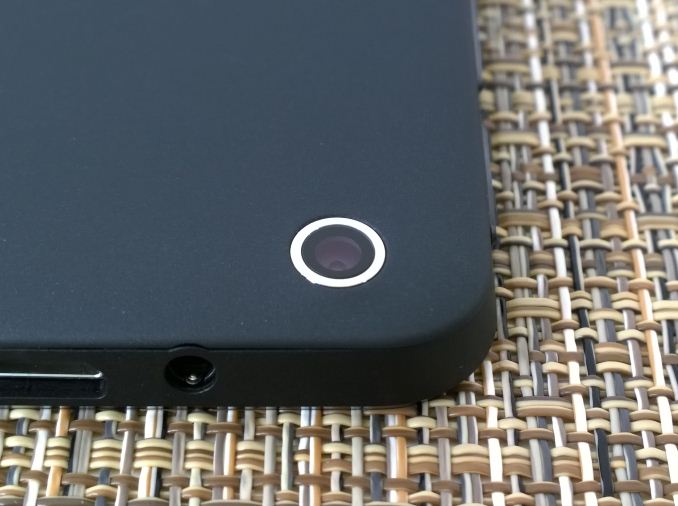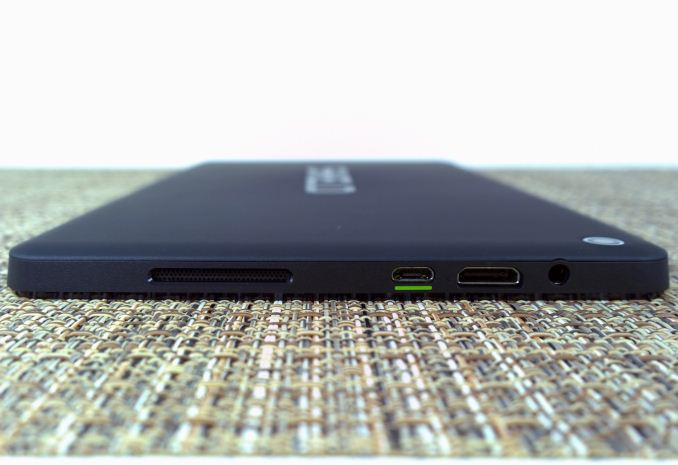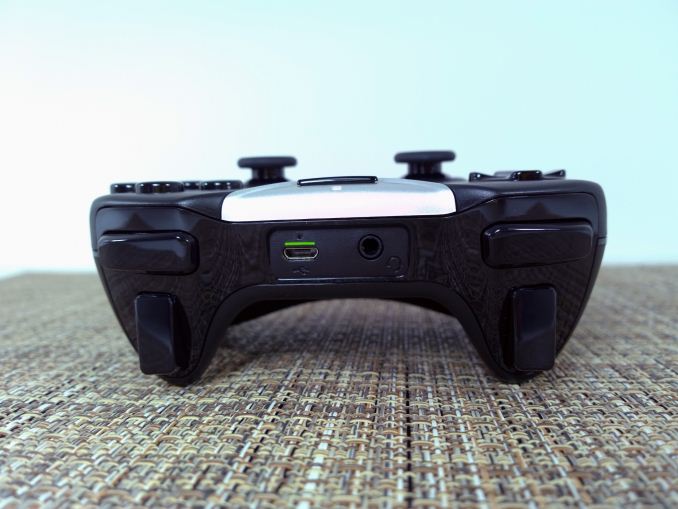The NVIDIA SHIELD Tablet Review
by Joshua Ho on July 29, 2014 9:00 AM ESTFinal Words
If I’m honest, it’s hard for me to review tablets. While I academically understand why people like tablets, I’ve never really found a use for them. They’re less comfortable to use in bed than a phone, I usually can’t type on a tablet as quickly as I do on a phone due to the size and weight, and in general it’s hard to justify a tablet when a phone is generally much more versatile. So when I got the Shield Tablet, I didn’t really know what to expect. While I have a Shield Portable, I don’t spend much time gaming on it, especially when I have a desktop that can do it much better. I came away from my experience pleasantly surprised.
Over the past five days, I’ve learned a lot about this device. As a tablet, it’s good. The material design and industrial design is acceptable and the device itself is quite ergonomic but it doesn’t blow me away. However, given the need to meet cost constraints, the matte plastic feel is really all that’s necessary and I don’t have any complaints in this area.
In the other fundamentals, we see a bit of a checkered pattern. In the display, the static contrast is quite high, and the calibration is good, but the gamut of the display doesn’t cover sRGB. This would definitely be an area that should be improved for the next generation. Although there are some compelling reasons to go with smaller color gamut, it ends up as a disadvantage when compared to other general-purpose tablets. The display is still perfectly usable, but it's a bit more washed out than I'd like.
In battery life, we see that the Shield Tablet ends up doing relatively well in web browsing, but for intensive gaming the tablet can’t spend much time away from an outlet before draining the battery completely. This is likely to be an unavoidable tradeoff, given the immense amounts of performance that Tegra K1 provides versus the power costs of doing so on a 28nm process. Anyone that has lived with a gaming laptop should understand this. As said before, it’s also possible to improve battery life from the 2.5 hour figure if the game is light enough to allow the GPU to run at lower frequencies. Barring that, NVIDIA has included options to cap the maximum frame rate of the display and reduce maximum CPU frequencies.
Otherwise the only other notable difficulty I’ve run into is with the stylus. Generally speaking it works well enough, but the stylus requires a bit more lift between words than I’m used to and keeping it from feeling fully natural. But I will be the first to admit that this is a minor issue at best.
Outside of the tablet itself, the gaming features are compelling. The larger 8” display and massively improved SoC on the Shield Tablet made for a far better gaming experience than what I had on Shield Portable. There’s a great deal of potential in ShadowPlay on a tablet, as while screen recording is nothing new in PCs this feature is often difficult to enable on Android. This is before we talk about the effects that live video encoding has on UI performance. ShadowPlay has managed to enable easy screen recording on a mobile device and do so without significantly impacting performance.
Meanwhile GameStream and GRID are even better on the larger screen that the tablet provides. While it was cool to play PC games on the Shield Portable, the size of the display simply made some elements too small to reasonably see. Now, there are no such issues. GameStream and GRID are definitely a lot of fun to use, especially if the game is well-adapted to playing on a controller.
Ultimately though, I feel that the native game library is the most important aspect of this device. While there are plenty of solid single player games, multiplayer games are few and far between. I still feel that multiplayer is where Shield has the strongest potential because it makes the difference between tens of hours per game and hundreds, even thousands of hours per game. There are definitely signs that this aspect of the ecosystem will improve in the near future as Trine 2 supports local multiplayer and War Thunder on Shield Tablet should be able to play online against console and PC players.
After getting through all of these observations over the past five days, I’ve come to realize that even though it’s not the perfect tablet, all of the features that this device brings to the table right now would be enough for me to seriously consider buying one. If NVIDIA manages to get enough multiplayer titles with an active community on Shield Tablet, there wouldn’t be a need to stop and consider at all. As someone that has spent the past few years never considering a tablet purchase at all, the Shield Tablet is the first ARM tablet that I would seriously think about buying.
The SHIELD Tablet is 299 USD for the 16GB WiFi model, 399 USD for the 32 GB LTE model. Each controller is 59.99 USD and the cover is 39.99 USD. While the 16GB model is 70 dollars more expensive than the Nexus 7 equivalent, the gap narrows to 50 dollars for the 32GB LTE model. Given the sheer amount of utility that this device brings to the table, the pricing is definitely set at the right place.














174 Comments
View All Comments
fivefeet8 - Tuesday, July 29, 2014 - link
Those arguments are the same ones made with the advent of gaming laptops and desktops. I can agree that the market for both is in the minority, but something needs to push the technology forward. At this point, the mobile space is ruled mostly by companies with technologies both hardware and software that have stagnated. Mostly because of the market conditions leaving pretty much only Qualcomm technology, but that has also caused them to become complacent to a large degree when it comes to software.schizoide - Tuesday, July 29, 2014 - link
Not really. Back in the day, games drove PC gaming hardware. You would go out and buy that new 3dfx card to play Quake 2. These days most PC games are console ports and low to mid-end hardware can play them just fine.Difference is that today there's an incredibly huge market full of mobile games with very modest hardware requirements, and very few are willing to release titles requiring top line hardware because the perception is those "core" gamers have consoles or gaming PCs.
You're right that if nobody builds mobile devices with higher-end capabilities those games will _certainly_ never come. That's dead on. But at the same time, I'm not going to buy a gaming device without an exclusive game that I really want. And 10 year old PC ports like portal don't cut it.
fivefeet8 - Tuesday, July 29, 2014 - link
That's the same argument you are making against the Shield Tablet. That it's hardware is not needed because most games run fine on lesser powered machines. Software has been playing catchup to PC hardware for years now, but we still have high end hardware to push the envelope.In any case, with the new Shield is a tablet that can do more than most on the market right now while still being able to push the technology forward. And you are correct, I wouldn't buy a gaming device either without a few games I really want, but then I'm not buying it simply for a gaming device only.
savagemike - Tuesday, July 29, 2014 - link
You might not buy a gaming device in that scenario. But this isn't just a gaming device it's also a tablet and as such can fill multiple uses.I'm not positive I'm going to buy one but I might. It's definitely on the list for consideration because it is so flexible. I wanted an 8"+ tablet and would very much like a stylus. Wasn't digging the extra price of the Samsung stylus models though.
For $300 this thing seems like it does lots of stuff pretty well. I would be surprised if there are not bundles for $325 or so that include the tablet and controller come the holidays.
We'll see. Want to see what the 64x version looks like too and also how pricing and quality play out for Android TV.
ArthurG - Tuesday, July 29, 2014 - link
comparing refurb price of a 6 months old item to a brand new model coming out today, very very fair...schizoide - Tuesday, July 29, 2014 - link
Sure. Why not? Money is money. You want to buy a small android tablet, Nexus 7 is at the top of your list, right?Friendly0Fire - Tuesday, July 29, 2014 - link
A lot of people don't consider refurbs. I know I don't.schizoide - Tuesday, July 29, 2014 - link
Fair enough, then it's only a 25% price premium. Certainly much more attractive, then.abrowne1993 - Tuesday, July 29, 2014 - link
The biggest problems I have with my 2013 Nexus 7 are CPU and GPU performance. If I didn't already have that tablet, I'd buy this one in a heartbeat.TheJian - Wednesday, July 30, 2014 - link
You must be kidding, comparing a refurb of an AGING product to a new product? $230 is the comparison, and for $70 extra you kick the crap out of nexus 7 2013. I didn't realize $300 was 2x $230. I guess I failed math.All the new games that come along with 20nm will likely have problems on that old thing, where K1 will keep on chugging (K1 will be the lowest common denominator next year at 20nm everywhere, and M1 or whatever they call maxwell version will be the new king). Not really interested in running all the games that are built for the lowest common denominator that will run on your aunt's galaxy s2. I'm interested in modern combat 5, asphalt 8, Ravensword, Dungeon Hunter 4 etc. All the stuff coming out this year and forward will get more potent. Though the old stuff is pretty nice too. The library keeps getting larger on android monthly.
Will they sell a lot of them? Tell that to google, they'll be using K1 in HTC Nexus 9. I'm guessing 10mil+ sell in that unit alone and it will probably be $400-500 ;) $300 for a tablet that blows everything else in it's class away is cheap. Get off welfare, get a better job etc and $300 won't sound like much more than $230...ROFL.
One of the other reviews did fine from North Dakota 1600 miles from California ;) Troll somewhere else please. Most of the ports have never sold more than 11mil (halflife2, Portal, Trine2 etc) so most people have never played the ports you're hating on. There are 1.2B android devices sold yearly now and growing. Next year with 20nm chips being at K1 level there will be 1.2B+ units top to bottom that can handle what K1 is doing and that will be what will create major game improvements. Everyone will be holding an Xbox360/ps3 in their hands that can act as a console output to tv. We're not talking angry birds any more even today. BTW, Trine2 came out 2011, Serious Sam3 BFE 2011, Portal 2008. We will start to see even more now especially after HTC Nexus9 hits. Not to mention companies like Gameloft, WB etc creating some top level stuff.